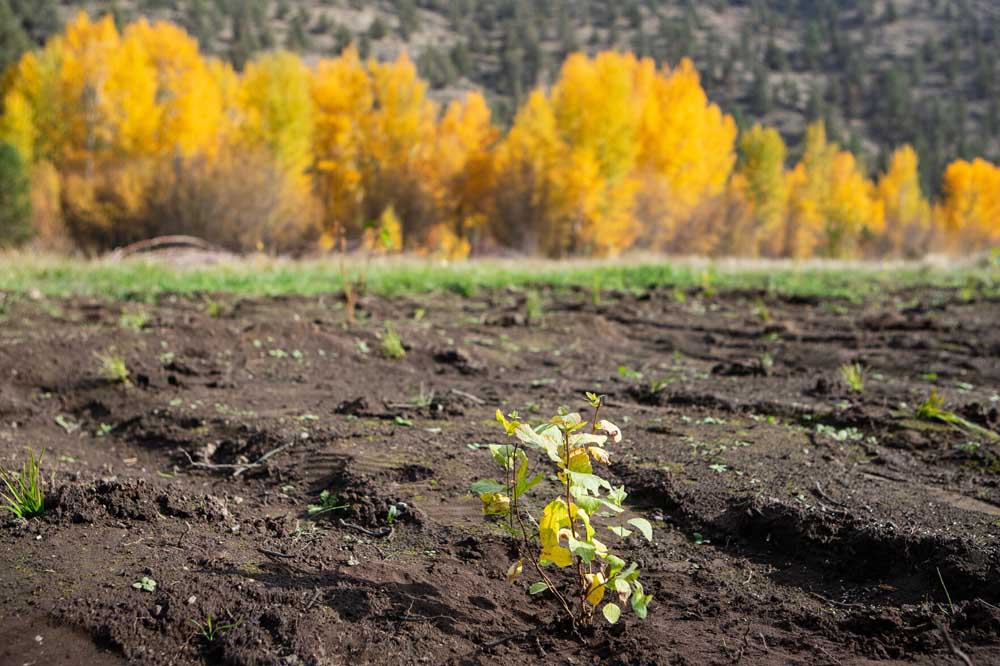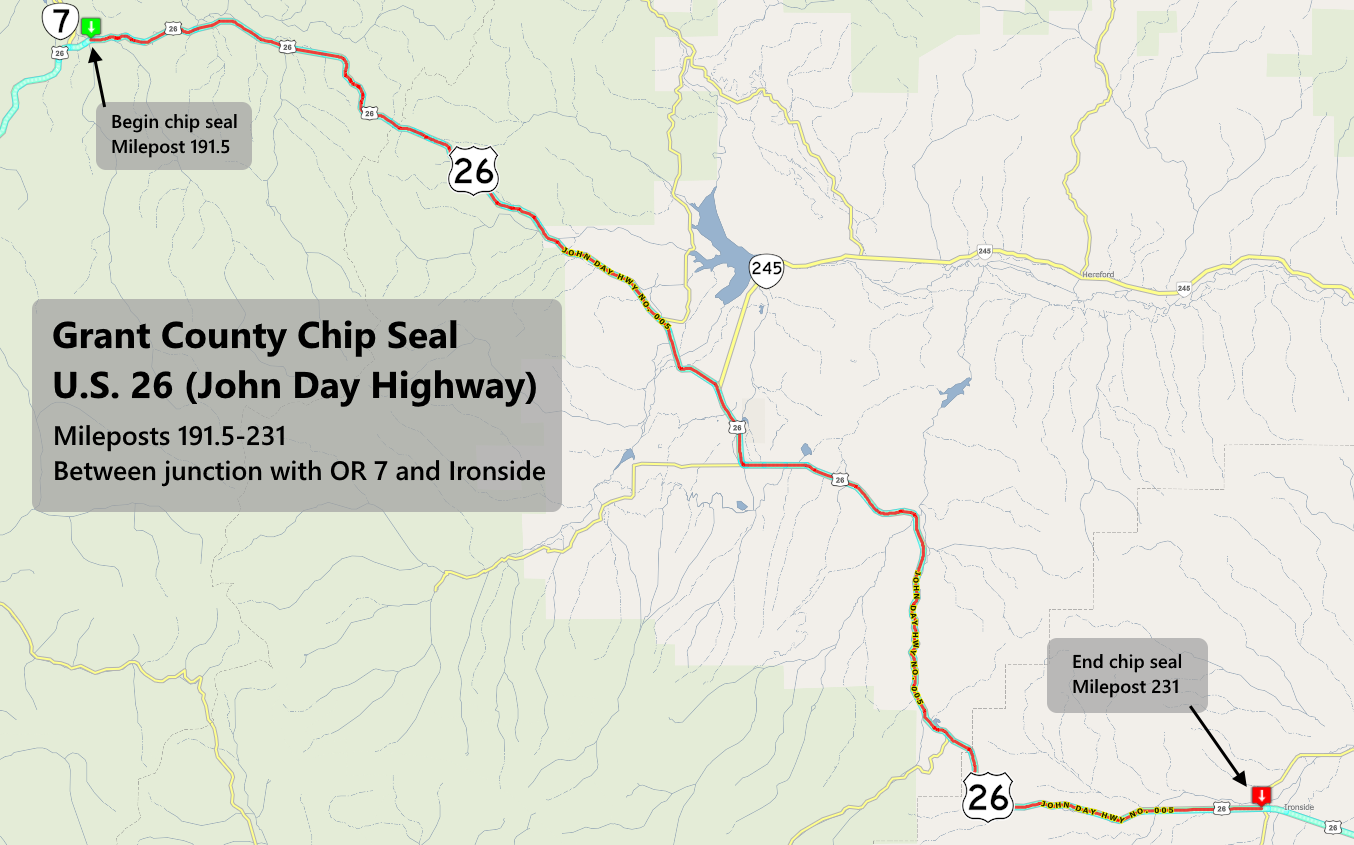This former pasture near Sisters has been transformed into a sanctuary for fish and wildlife
Published 5:45 am Thursday, October 26, 2023

- A newly planted tree sits near the bank of Whychus Creek at the Rimrock Ranch site outside Sisters on Friday. Restoration work at the site, including tree and shrub planting and placement of logs and downed trees, is nearing completion.
SISTERS — In the mid-20th century, the flow of Whychus Creek was manipulated for agricultural production, irrigation and flood control. The changes periodically dried up the river bed and eliminated natural pools, channels and habitat diversity needed by fish for the different stages of their life.
Last week, a group of volunteers did their part to reverse the decades of change.
The volunteers, around 30 of them from different organizations and nonprofits, descended on Rimrock Ranch around 10 miles northeast of Sisters to plant trees, shrubs and grasses along the banks of the Whychus Creek in an effort to restore the natural landscape.
The planting is the culmination of five months of work by the Upper Deschutes Watershed Council, which is spearheading the effort to restore the natural landscape along the creek. The council is a non-profit group dedicated to restoring natural habitats along the Deschutes River and its tributaries.
The work included leveling out a berm built in the mid-1900s that changed the flow of the creek, which has its headwaters in the Three Sisters Wilderness.
Once the berm was removed, the adjacent cattle pasture was restored and is now connected to the river as part of the floodplain. Satellite imagery was used to determine where the river flowed decades ago.
More than 4,500 logs were then placed into the channels and floodplain with heavy equipment to replicate a natural river system. The work done this year carried a price tag of $1.5 million.
“Whychus Creek was straightened and pushed to one side of the valley. Bermed,” said Kris Knight, executive director of the Upper Deschutes Watershed Council, explaining how the valley changed some 75 years ago. “Because they wanted to create these meadows, they wanted to maximize the area for grazing for agriculture for flood control.”
Changing attitudes
Knight said attitudes have changed in recent years about human impact on the landscape and the results of manipulating the flow of water.
“We have learned a lot over the decades. We thought we needed to straighten and berm these creeks so the water moves through and it won’t flood. Well, that is not good for fish or wildlife. The water was coming down the valley like a firehose. We are trying to put it back to what it was,” he said.
This year’s work was just the latest in a series of projects to restore the Whychus Creek. In 2021, the Upper Deschutes Watershed Council restored a half mile of the creek upstream from this year’s project area. A one mile portion further upstream was restored in 2016.
The Deschutes Land Trust, an environmental non-profit, owns six miles of land straddling the creek. So far, three miles have been restored.
Cougar, mule deer and elk inhabit the nearby forests. Beavers have already moved back into the area that has been restored. The stretch of creek is critical habitat for several species of fish, including spring chinook and steelhead trout, which swim up the Deschutes and use the Whychus as spawning grounds.
“Essentially what you had through this valley was a canal, a conduit to get water through as quickly as possible,” said Gonzalo Mendez, a fisheries biologist with Portland General Electric and one of the volunteers who helped with the planting work last week.
“Now at least for these three miles you have habitat and structure and a place that is suitable for multiple life stages of fish as they return back to spawn in this area. So it’s considerably different. Night and day,” he said.
Mendez said spring chinook, some of them 20 to 30 inches long, can now pass through Whychus Creek, thanks to stream improvements.
“For a little tiny stream like this, it’s very impressive,” he said.
Restoring the habitat
The volunteers planted around 1,000 trees and shrubs. Prior to their work, BCI Contracting, a Tigard company, served as the heavy equipment and restoration contractor while Bend-based Quicksilver Contracting Co. did the planting, putting in around 39,000 trees and shrubs.
In addition to restoring habitat, one aspect of the work done last week was to connect people with Whychus Creek by having them plant trees in the valley. Under a blue sky on a crisp fall day, with yellowing aspens and cottonwoods around them, the volunteers dug shallow holes in the earth and placed hundreds of trees in the ground.
Mendez, usually based in Madras, said these days he spends a lot of his time behind a desk in an office and the chance to work in nature was something he couldn’t pass up.
“These are the best days,” he said. “On days like this, when the sun is shining and trees are rustling and birds are singing, that is why I got into this field to do most of the time.”
Mendez said once the vegetation grows it will provide dead wood to improve stream habitat in the future.
“We jump start it by putting dead wood (in the stream). We plant live plants. Those in turn will produce the next generation of trees which will then become the dead wood that will fall into the tributary and become habitat,” said Mendez.
The thousands of trees placed into the floodplain were cut from properties near Sisters with funding from the Oregon Department of Forestry as part of work to reduce wildfire risk. Rather than burning them in piles, which is what is normally done, they are now used for fish and wildlife habitat.
Meandering creek channels
The project’s broader goal is to promote meandering creek channels where fish can find cover, cold pools and spawning areas, said Knight. Additional planting is expected over the next two years. The logs in the valley will shift over time as the elements move them around.
“The stream can go where it wants to go and there can be multiple channels,” he said. “We are trying to create a creek that is dynamic and can move. We are trying to restore it to as natural a state as we can.”
In addition to creek restoration near Rimrock Ranch, the Upper Deschutes Watershed Council has been instrumental in removing dams and barriers to fish passage further upstream.
Two years ago, the non-profit removed Plainview Dam, a barrier that prevented fish from migrating to the farthest reaches of Whychus Creek. That was the last of six barriers for fish passage removed in Whychus Creek.
Other non-profits and irrigation districts have also worked together to restore stream flow in Whychus Creek over the past two decades.
“Whychus Creek used to go dry two out of three years,” said Knight. “It has been a 20-year story but it’s a success story and it will keep unfolding. Part of that is to restore the creek and watershed and part is to create habitat for reintroducing salmon and steelhead. Not just the fish, but the birds, the insects, the cougars, the eagles, everything.”
The public can access a portion of Whychus Canyon but visiting the Whychus Canyon Preserve, a 930-acre protected area. The preserve is located 25 miles northwest of Bend, at the end of Goodrich Road.
The area at Rimrock Ranch has no public access but Deschutes Land Trust offers occasional tours which are expected to start in the spring of 2024. Individuals interested in seeing their area can check their website for updates: deschuteslandtrust.org






